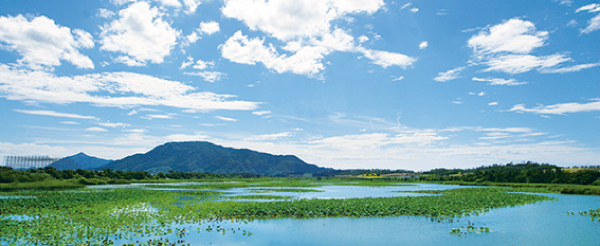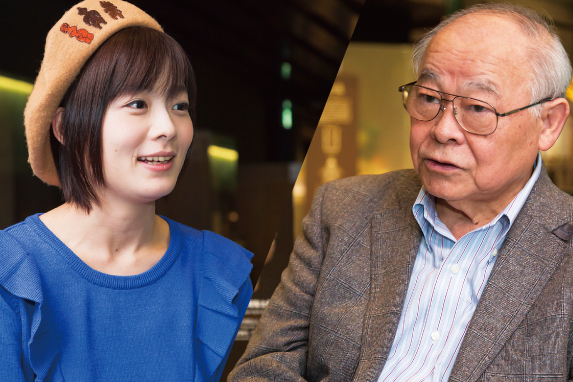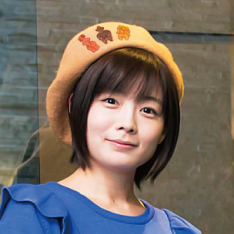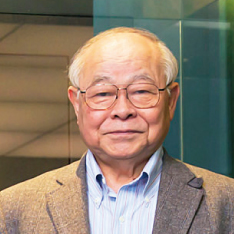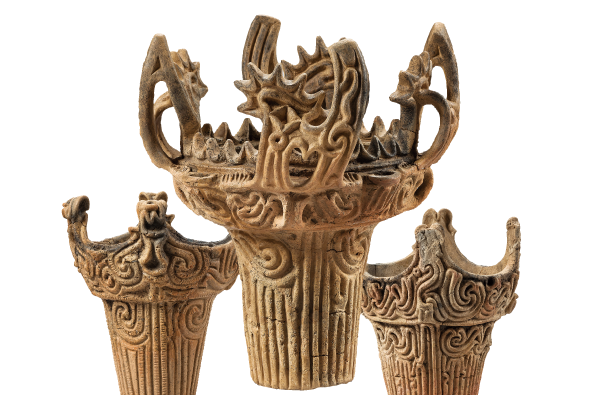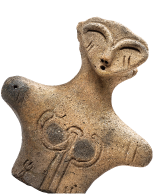What kind of age was the Jomon period?
Fujioka:There are many ways to interpret the Jomon period. In my case, I found the age lively at first and then it gradually appealed to me. I long for the Jomon period as it seems to have been an age when people were warmhearted. What do you think about the Jomon period, Professor Kobayashi?
Kobayashi:People who think of the Jomon period at a distance may find the Jomon period lively. I’m much closer to the Jomon period and am struggling with it. So, I don’t feel it was lively. Why do you think it was lively? It’s our responsibility to find the answer and examine it.
Fujioka:What was the primary feature of the Jomon period and how did people live then?
Kobayashi:Jomon pots represents the Jomon period. To make pottery, they found clay, refined it and kneaded it, adjusting the softness by adding water. It is similar to baking bread.
Fujioka:I’ve tried to make pottery modeled on a flame pot. I thought making pottery was sophisticated.
Once clay is kneaded, it is left as is for a while. Then a bottom was made with a lump of clay, and a wall was made around the bottom. After finishing the whole body, they decorated its surface, dried it and fired it.
Kobayashi:Their starting to make pottery, which needed much time and work, lead to the dawn of the Jomon period and became its primary feature.
Fujioka:That’s right. If they hadn’t had settled down, making pottery would have been impossible. It was more than 13,000 years ago, when the oldest pottery in the world was produced on the Japanese archipelago. It was the first and the biggest revolution for human beings. The emmergence of pottery has the stabilized sedentism in the background.
Kobayashi:It’s amazing that something so old still remains now. Jomon pots featuring the Jomon period also tells us how people lived in those days. How interesting!
Fujioka:It’s amazing that something so old still remains now. Jomon pots featuring the Jomon period also tells us how people lived in those days. How interesting!
Exciting Jomon Culture
Fujioka:Jomon pots is really great. Speaking of Jomon pots, many people picture flame pots. How is this pottery superior to others?
Kobayashi:As we have pottery like Bizen ware and Hagi ware now, individual pots styles developed in each region in the Jomon period, like dialects. As the proverb says: so many countries, so many customs.
Fujioka:I guess Jomon pots was an object that people in the Jomon period showed their pride and character with, comparing themselves to people in other regions.
Kobayashi:In short, they were seeking their independent identity in Jomon pots. That’s why Jomon pots characteristics differ depending on regions and ages. Some of the characteristics are breathtaking and also are universal.
Fujioka:What are they?
Kobayashi:They are projections on the rim. Jomon pots are containers. As containers, it’s enough for them to have a certain capacity. But Jomon pots had projections to decorate the pottery rims.
Fujioka:Jomon pots with projections must’ve been difficult to handle.
Kobayashi:Projections are unnecessary for containers, but they made them, even complicated ones. They brought in and used much clay, spending substantial time on the projections. However, Jomon pots with projections was difficult to handle, which appears to have been a contradiction. This contradiction is unique to Jomon pots and cannot be seen in any other pottery in any ages, areas or countries.
Fujioka:I thought projections weren’t practical. I wondered if there was a reason for them or if they were mentally important for people in the Jomon period.
Kobayashi:The projections were useless objects, but they put them on top of their pots. A very strong will must have made them do that.
Fujioka:That sounds very touching. When I visited Niigata the other day, people there cooked miso-soup with pork and vegetables (tonjiru) with pottery modeled on a flame pot. When I ate the tonjiru, I felt it a very special food. I felt as if it were celebrated tonjiru, though the projections bothered me when I used a ladle. But I love pots with projections, which is a contradiction. I thought I may be able to recognize the feeling of speciality.
Kobayashi:It’s very important because clay is flexible and easy to be shaped. That was a common understanding not only for Jomon people but also for the potters all over the world. If I dare to use the expression "got carried away," the Jomon people were the most to be carried away with the flexibility of clay.
Fujioka:It’s like: Let's do it as far as we can! I was surprised to know that the number of projections were fixed. They would sometimes do figures beforehand.
Kobayashi:Just adding projections is insufficient. We need to think about balance. So, the number of projections is basically an even number; normally there are four projections including the flame pots. In the same period, pottery was made in other places such as on the Korean Peninsula, the Chinese continent, Taiwan and Sakhalin, but they didn’t make projections. Only Jomon pots had projections.
Fujioka:The projections must have been necessary for some reason.
Kobayashi:There should be a reason for it; they would not have made projections without a reason. Flame pots has four projections in principle, but pots made in Aizu has three. They had a similar style to make pots and expressed their independence with the projections.
Fujioka:I can feel their mental strength. Counterculture! Expressing with the number of projections!
Kobayashi:I heard that Taro Okamoto was so surprised at the ferociousness and magnificence of this figure that he almost fell. The Jomon formative art moved him as an artist. If we want to understand the flame pots more specifically though, we should change our perspective and think more deeply.
Fujioka:How?
Kobayashi:For example, projections are called cockscombs, combs of roosters, as a nickname, which were essential. On the horizontal rim, where cockscombs are put, saw teeth-shaped frills are added. Moreover, symbolic heart-shaped windows are made on the side of the cockscombs.
Fujioka:They already had a heart shape, didn’t they?
Kobayashi:Yes. In addition, there were protrusions in the shape of big-framed glasses that look like the dragonfly eyes and of bag. Every flame pots had these patterns. That suggests that the patterns went beyond decoration to what they wanted to tell, which was the hidden story that originates from their world view. Interestingly, all flame pots earthenware excavated from the region of Niigata to Tsunan, on the upper to lower Shinano River, followed this tradition.
Fujioka:Did they deform something and make a new pattern? What did they intend to tell? There are riddles for us to solve.
Kobayashi:One more thing interests us. Flame pot alone was insufficient for them. They also needed crown-type pot, which was a brother version.
Fujioka:I can understand it’s a brother version because they indeed resemble each other. There must have been a reason a brother version appeared.
Kobayashi:There’s a mutual concept between them. I mean, there should be a pair in their concept and style. For example, heads and tails, light and shadow, and day and night. This is the dichotomy between the two: the concept of distinguishing two things. They dared to make it and express it. I call this two but one Jomon thought.
Fujioka:When we look at Jomon pots, we can imagine something like the Jomon philosophy. Many of us connect the Jomon period with primitive life. I did at first, but now Jomon pots makes me think that they must’ve had philosophy. When I think they seem to have had strong wills and been rich in emotions, I feel familiar with them and that I would have been able to make friends with them. I also feel empathy with them more strongly when I look at their clay figures as well as their pots. Speaking of clay figures, they remind us of Miss Umataka, a clay figure found in Niigata prefecture. Her cheeks look plump and she is adorable. She has facial expression, too. Clay figures were deformed, which I think made them adorable; they appeal to me.
Kobayashi:As for deformation, when they made a clay figure’s face, they tried to make it as different from a human being’s face as possible.
Fujioka:I thought so. Judging their technique from flame pots, we can assume that they would be able to make more realistic clay figures of human beings, which would be easier to understand. But they didn’t.
Kobayashi:I think they were spirits. There may have been spirits around them. We have experience like feeling someone looking at you from behind and when you look back the figure disappears. They recognized the existence of spirits and made clay figures. They didn’t make faces because they would have become human if they had human faces. That’s why clay figures were faceless in the beginning.
Fujioka:Is that so?
Kobayashi:Faceless clay figures had been produced for thousands of years. Clay figures were faceless until the age of flame pots. Someone may have daringly made a face on a clay figure. Some people were reluctant to make clay figures with faces, but more and more people began to make them.
Fujioka:I was surprised to hear that clay figures were not human beings in the beginning. They were not animals either, right? That means they intentionally made something that does not exist.
Kobayashi:There’s no one whose face looks like a clay figure, but they made it. As clay figures with faces were produced, some clay figures began to be broken, which had a reason.
Fujioka:Many clay figures have had their legs removed. There must be a reason and that may be culture.
Kobayashi:There are practically no able-bodied clay figures. Clay figures are very different tools from Jomon bows, arrows and spears, which were used with hands. Clay figures were tools used with brains. I call them the second tool.
Fujioka:They made what they wanted to make, not what was easy to use. I like that.
Kobayashi:The flame pot style was at the time when the Jomon culture developed vigorously, and reached its peak in the middle Jomon period.
Fujioka:It was the Jomon bubble, right?
Kobayashi:The area producing flame pots then was exactly in the present Niigata Prefecture, which is interesting. Niigata Prefecture used to be called the Echigo District in ancient days. The territory is based on the area that flame pots were made. A cultural area was formed centering in the Shinano river Basin.
Fujioka:Do rivers relate to the development of civilization?
Kobayashi:Japan has many rivers. The cultural sphere of flame pots, which clearly fits with the border of Niigata Prefecture, had rich cultural activities in the Shinano river Basin. We applied for the Japan Heritage project held by the Agency for Cultural Affairs in order to familiarize the culture of the Echigo District, centering on flame pots and the culture symbolizing the Jomon period and it was adopted.
Fujioka:When I visited Nagaoka City and looked at flame pots, I learned that areas were divided according to Jomon pots features. I can imagine Jomon people may have felt like boasting: this is our pots! I think flame pot was something that they were proud of.
Kobayashi:Projections were added to the Jomon pots which are not necessary for containers. We cannot find this kind of thing in any other area or on any other continent. That makes Jomon culture so emotional. So much so that everyone will understand why you had a lively and touching image with the Jomon.



